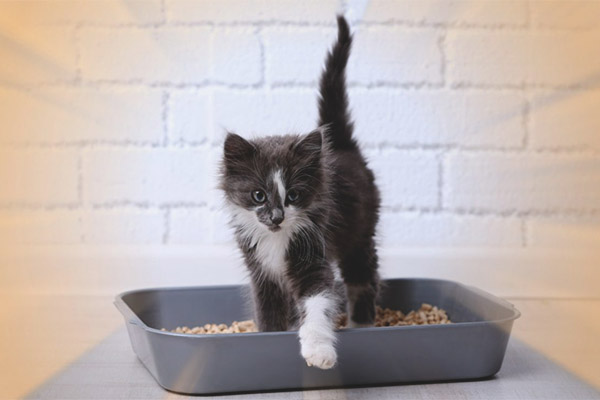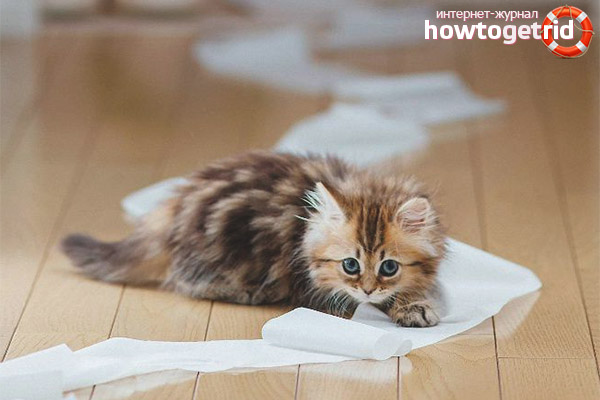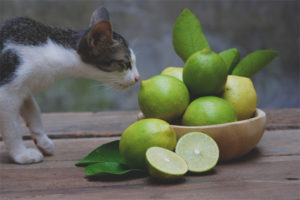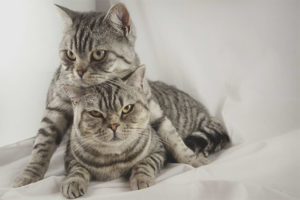The content of the article
Usually the cat is closely watching how her kittens go to the toilet. After each time, she carefully lick them to keep her cubs clean. But when a kitten appears in the house, and its mothers are no longer nearby, the new owners should themselves monitor how correctly the animal's digestive system works.
In order for a healthy cat to grow from a kitten, it is necessary that he has a normal stool. Therefore, everyone who has a kitten in the house should know what problems a kitten has with a chair, what is the norm, and how to treat disorders related to digestion.
Newborns
During the first 3 weeks of life, a cat watches the little kitten’s toilet. She carefully licks them to not only eliminate dirt and odor, but also to stimulate blood circulation in the digestive system.
After such a massage, the kitten is easier to empty, it gets rid of gases without any problems. When a mom-cat licks dirt from a kitten, it may seem that he does not have a bowel movement at all.
If the cat does not provide the necessary care for your baby, or for some reason is not around, you can help him on your own. If at this age the baby can not go over large, you must perform certain actions.
You need to prepare a soft brush or a piece of cotton that is wetted in warm water. Massaging the kitten's belly in a circle, and then doing a light body massage from the head to the hind legs. Such actions should help the newborn kitten to empty the intestines.
In the fourth week of life, a sufficient number of microorganisms is found in the kitten’s intestines. Therefore, at this age, he begins to gradually consume adult food. Accordingly, at this time, part of the diet should still be mother's milk, but complementary foods are gradually introduced. It is a liquid or creamy food. It does not need to be chewed, and the intestines are quite easy to handle.
If the kitten cannot empty the intestines for 4 days, it is necessary to reconsider its diet. You can help him with an ordinary belly massage. You can give him some vegetable oil or make microclysters.
Adult kittens
At the age of 1-3 months, the kitten begins to give adult food. Feces start to get a clearer shape. The frequency of bowel movements will depend on what kind of food you feed the animal. If there is a lot of fiber in the diet, the pet will empty the bowels more often. If in food more protein - less.
At this age, defecation should occur daily. In the feces should not be observed mucus, blood, as well as pieces of undigested food. If the feces are liquid and the animal goes to the toilet often enough, this is a violation of the norm.
Urination frequency
The more fluid a kitten drinks, the more often he will write. At an early age, the bladder of the animal is still very small, so it will walk more often in a small way. This usually occurs about 10 times a day, and at an older age - up to 5 times. The norm for an adult animal is 3-4 times. It is necessary to ensure that the pet does not experience discomfort during urination. You should observe the color of urine, the presence of blood, mucus.
How to understand that a small pet wants to go to the toilet?
- He scrapes his paws on the surface of the floor or any objects.
- Begins to smell around objects to find a place. He is trying to find the most secluded place.
- Begins to stagnate, squeak, crouches slightly.
- When the kitten is about to go to the tray, his eyes look glazed. If you notice this, it is better to take the pet to the tray as soon as possible.
Causes of problems
Your little pet may not go to the toilet for a long time as a result of stress. For example, he is worried about the move, he has a new owner, or he has been taken away from his mother.It is necessary to provide him with such conditions in which it will be much easier for him to get used to and get used to. Additional stressful situations during this period should be avoided. Protect it from loud sounds, games. Let the pet master itself. Soon he will start playing here, he will normally go to the toilet, without fear of moving around the territory. But if the defecation does not occur within 5 days, the help of a veterinarian is necessary.
Delays can also occur due to nutritional errors. If you purchased a kitten, be sure to ask what it was eating. If you want to change his diet, it will need to be done gradually.
If the pet is already accustomed to the house, and to the food, but within 5 days he still did not go to the toilet, most likely it is constipation. In this case, the tummy should be swollen. If an animal stays in a tray for a long time, meows - it means that this process is painful for it.
Help with constipation
How can you help your little pet if he has constipation?
- If the kitten has problems defecation, try to give him regular vegetable oil. For it will be enough a few ml, it is about half a teaspoon per day.Oil is collected by a syringe, and then gently injected into the pet's mouth.
- Vaseline oil, which can be added to food with 0.5 ml each time, will also help. Additionally, you can do a belly massage.
- Make a thin small peg from a piece of baby soap, and then insert it into the kitten's anus. Before this peg should be wetted with warm water. This procedure is best done when the kitten is sleeping. After this, after 2-3 hours, a successful defecation should occur.
- If these remedies do not help, contact your veterinarian. He will tell you what medicines you can give your pet to help him.
You can also make a kitten an enema, but before that you should make sure that this procedure does not bring harm to the animal. It will only be safe if the cause of constipation is improper nutrition. But in case of intestinal obstruction, it cannot be done. It is forbidden to give an enema to animals that have any inflammation or bleeding in the intestine.
How to put an enema: you need to prepare a syringe with a volume of 10 ml, a little petroleum jelly or vegetable oil, warm water. It is better if the procedure will perform 2 people.One must hold the animal, and the second - to introduce a syringe. Before the introduction it must be lubricated with petroleum jelly. It should be injected so deep that the water is distributed normally. Water is injected slowly, in the process of feeling the kitten's stomach, in order to understand how much the intestine is filled with fluid. In total it is necessary to enter 50-100 ml of boiled water.
general information
At a very early age, the pet usually walks about 10 times a day in a small way. And in the period of maturation, the number of urination is reduced to 5 times. And if he walks a little more often 10 times or less than 5 times a day, and also if he detects any impurities in his urine, such as blood or mucus, he should consult a specialist.
Kittens at the age of 1 month go for about 3-6 times a day. But, if you just brought a small pet into the house, it may be under stress. Therefore, he can get used to a new place for up to 5 days, after which the little pet should get better digestion. If this does not happen, it should be shown to a specialist.
Many owners are interested in how often to change the tray of the animal. It depends on what kind of filler you use. It is important to ensure that there is no smell after using the toilet. If the smell remains, the next time the animal will look for another place. Therefore, the contents of the tray is better to change.
Video: how to teach a kitten to go to the tray













To send